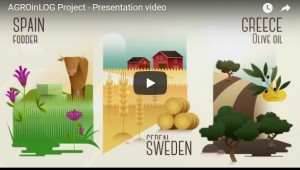
Integrated Biomass Logistics Centers (IBLCs) are business strategies designed to allow agro-industries to link to the growing bio-based economy by “taking advantage of unexploited synergies”, such as facilities and personnel, as well as inputs and outputs. The primary goal of IBLCs is to optimise the usage of European agro-industries, whose goods and facilities would otherwise remain under-utilised due to seasonal constraints. The EU project AGRO inLOG aims to involve the agrarian sector in supplying solid biofuels in Europe. It is primarily focused on implementing Agro-industry Logistics Centres (ALC), which can potentially be used to treat biomass so that it can be sold.
IBLCs are identifiable by their four different elements:
- Integrated: i.e. integrating “value-adding activities” in terms of food and bio-based markets. By combining the existing food-supplying system with ‘intermediate products’ – such as energy and biomaterials – IBLCs have the potential to deliver higher profits (based on favourable market conditions). These products are predominantly aimed at the ‘business-to-business’ market (in-industry purchasing of intermediate bio-products), however, they can also be directed at the consumer market and governmental institutions.
- Biomass: such as residues in the proximity of agricultural production sites, which can be harvested cheaply and easily. However, this must not damage the primary crop, nor should all the biomass be harvested at once, as a constant presence of residues in the soil is essential to avoid its depletion. While this issue restricts the availability of biomass to a time-specific seasonal cycle, it can be addressed by using a matrix to identify the type of biomass and the various alternatives that can be used to deal with it.
- Logistics: i.e. things to be considered when setting up an IBLC, such as transportation, safety requirements, harvesting and handling procedures. These technicalities will define the quality of the end product (biomass), and also limit the combination of food and non-food production in the same IBLC. Thus, knowing the duration of the ‘idle period’ of a facility is essential to optimise production, as is assessing the technical feasibility of the given capacity. These are critical steps that will ensure that the volume and timing of biomass/residue availability will be adequately configured.
- Centres: exploiting the central position of the IBLC: i.e. maximising the benefits of a given IBLC’s geographical position, to reduce transportation distances and costs. Considering its position relative to centres of distributions of the biomass is also important, particularly regarding the regional market.
Biomass is expected to play a major role in the future in terms of energy supply, and other bio-based functions and products. This requires investments in infrastructure for its transportation and transformation. Existing agri-businesses should look to develop IBLCs to diversify their inputs and outputs. They should also be prepared to invest to optimise available and new capacity.This can be done by using extra feedstock types for the input, thus obtaining extra revenue for their new outputs. It can also be achieved by maximising existing processing capacity.
IBLCs also make biomass available for refinery processing. This can result in a mutually beneficial process for IBLCs and the bio-refinery industry, as the former can provide a constant and secure feedstock supply for the latter, which in turn can provide a market distribution system for biomass.
This can be achieved by ‘typifying’ IBLCs, which means creating a design or blueprint for different subtypes of IBLCs according to their functions. These subdivisions can essentially be traced back to the three different ‘drivers’ identified earlier (input, output and processing), which can also be combined. Other factors to be taken into consideration when typifying IBLCs are the type and number of inputs (e.g. single-source biomass), the number of processing steps and pre-treatments required, and the type of outputs involved. It is also important to note that an IBLC value chain “will always be case-specific for the type of feedstock(s) collected”, which will impact a specific site’s design and processing steps. By doing this (in accordance with EU and local regulations, of course), it will be possible for European agri-businesses to actively and fully participate in what is an increasingly promising sector.
Find out more at www.http://agroinlog-h2020.eu
This post is based on the paper “Conceptual Description of an Integrated Biomass Logistics Cente (IBLC)”, B. Annevelink, B. van Gogh, F.S. Nogués, S. Espatolero, T. De la Cruz, D. Luzzini, M. Karampinis, M. Kougioumtzis, J. Olsson, presented at the 25th European Biomass Conference and Exhibition.


